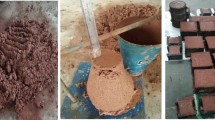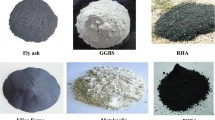Abstract
Vanadium-beard bone coal is one of important vanadium resources in China. to extract vanadium tailings from Stone coal is prduced after extracted vanadium from stone coal through the roasting, leaching and other processes. About 120-150 tons of tailings will be produced in extracting 1 ton of vanadium pentoxide. A lot of tailings that are willfully piled up have caused serious environmental pollution and wasting of resources; it is therefore necessary to realize its resource utilization. This study increases the activity of vanadium tailings by means of alkali fusion, and then uses different alkali activators to react with vanadium tailings so that geopolymer with high value added is produced. Sample of geopolymer is acquired from mixture containing vanadium tailings, alkali activators, water and a little sodium aluminate through compression-molding process under 20MPa pressure. After cured in room temperature for three days, the maximum compressive strength of the sample can reach 36.2MPa. XRD analysis indicates: quartz, the major crystal phase in vanadium tailings is decomposed and the activity of vanadium tailings is heightened. FTIR and SEM analyses show: structural change having important impact on the mechanical strength of geopolymer occurred during the process of vanadium tailings generating geopolymer.
Similar content being viewed by others
References
K. Komnitsas, D. Zaharaki. Geopolymerisation: A review and prospects for the minerals industry. Minerals Engineering, 2007, 20: 1261–1277
J. Davidovits. Geopolymers: Inorganic polymeric new materials. Journal of Thermal Analysis, 1991, 37(8): 1633–1656
P. Duxson, J. L. Provis, G. C. Lukey, J. S. J. van Deventer. The role of inorganic polymer technology in the development of “green concrete ”. Cement and Concrete Research, 2007, 37: 1590–1597
J. Temuujin, A. van Riessen. Effect of fly ash preliminary calcination on the properties of geopolymer. Journal of Hazardous Materials, 2009, 164: 634–639
Zhang Shuzheng, Gong Kecheng, Geopolymers Journal of Materials Science and Engineering, 2003, 21 (3): 430–436.
Wu Jing, Study of New Geopolymer-Based Building Material, Wuhan, Wuhan University of Technology, 2007.
Wang Feng, Zhang Yaojun, Song Qiang, et al. Study of NaOH Activating Slag Geopolymer. Nonmetal Minerals, 2008, 31 (3): 9–11
I. Maragkos, I. P. Giannopoulou, D. Panias. Synthesis of ferronickel slag-based geopolymers. Minerals Engineering, 2009, 22: 196–203
Wang Guodong, Fan Zhiguo, Lu Douyou, Impact of Silicon-Aluminum Material on Preparation and Performance of Geopolymer. Bulletin of the Chinese Ceramic Society, 2009, 28 (2): 239–244.
SUN Pei-jiang. Fly ash based inorganic polymeric building material. Detroit: Wayne State University, 2005
P. Duxson. The structure and thermal evolution of metakaolin geopolymers. Melbourne: The University of Melbourne, 2006
Lu Qiuyan, Study on Preparation and Application of Artificial Mineral Polymer, Fuzhou: Fuzhou University, 2005.
Zhang Yunsheng, Sun Wei, Li Zongjin. Composition design and microstructural characterization of calcined kaolin-based geopolymer cement. Applied Clay Science, 2010, 47: 271–275
H. Xu, J. S. J. van Deventer, G. C. Lukey. Effect of alkali metals on the preferential geopolymerization of stilbite/kaolinite mixtures. Industrial & Engineering Chemistry Research, 2001, 40: 3749–3756
Z. Zuhua, Y. Xiao, Z. Huajun, et al. Role of water in the synthesis of calcined kaolin-based geopolymer. Applied Clay Science, 2009, 43: 218–223
D. Panias, I. P. Giannopoulou, T. Perraki. Effect of synthesis parameters on the mechanical properties of fly ash-based geopolymers. Colloids and Surfaces, 2007, 301: 246–254
J. Davidovits. Geopolymers: Inorganic polymeric new materials. Journal of Materials Education, 1994, 16: 91–139
A. V. McCormick, A. T. Bell, C. J. Radke. Evidence from alkali-metal NMR spectroscopy for ion pairing in alkaline silicate solutions. Journal of Physical Chemistry, 1989, 93: 1733–1737
T. W. Swaddle, J. Salerno, P. A. Tregloan. Aqueous aluminates, silicates, and aluminosilicates. Chemical Society Reviews, 1994, 23: 319–325
W. K. W. Lee, J. S. J. van Deventer. Structural reorganisation of class F fly ash in alkaline silicate solutions. Colloids and Surfaces, 2002, 211: 49–66
A. Fernadez Jimenez, A. Palomo. Mid-infrared spectroscopic studies of alkali-activated fly ash structure. Microporous and Mesoporous Materials, 2005, 86: 207–214
Author information
Authors and Affiliations
Rights and permissions
About this article
Cite this article
Chen, Tj., Zhang, Ym., Jiao, Xk. et al. Research on Preparation and Performance of Vandium Tailings-based Geopolymer. MRS Online Proceedings Library 1380, 15 (2011). https://doi.org/10.1557/opl.2012.412
Published:
DOI: https://doi.org/10.1557/opl.2012.412




